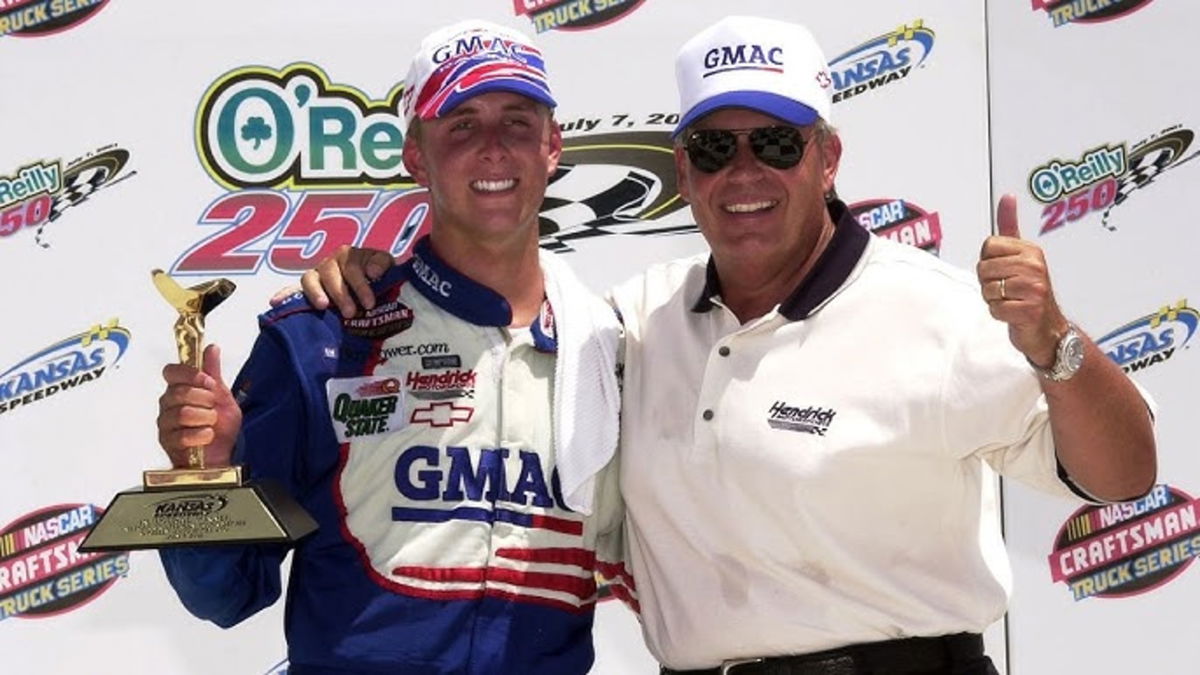

I experienced one of the most tragic in-person episodes of my longtime journalist career. Sunday, October 24, 2004, started as many October days do in Martinsville, south central Virginia: with a heavy cloud cover, occasional mist, heavy fog, slight winds, and a chilly temperature in the low 50s.
Watch What’s Trending Now!
Around 10 a.m. ET and a little over 100 miles away, 10 individuals climbed aboard a Beechcraft King Air 200 team airplane owned by Hendrick Motorsports in Concord, North Carolina. Their destination: Martinsville Speedway, for NASCAR’s Subway 500, the 32nd race of that year’s 36-event Nextel Cup schedule.
Among them: Rick Hendrick’s younger brother, HMS President John Hendrick; John’s daughters Jennifer and Kimberly Hendrick; Rick Hendrick’s only son, Ricky; HMS Engine Director Randy Dorton; HMS General Manager Jeff Turner; Dupont Racing Director Joe Jackson; Tony Stewart’s helicopter pilot Scott Lathram; and the plane’s two pilots, Richard Tracy and Elizabeth Morrison. One name, however, was absent from that day’s passenger list.
ADVERTISEMENT
Illness kept Rick Hendrick away from the trip
Rick Hendrick, that week, had a touch of the flu and decided to skip the flight – a decision that saved his life. The elder Hendrick had promised his son that he would inherit the organization when Rick eventually stepped down. Ricky had already shown the initiative and success inherited from his father, as the Busch Series team he owned, with Brian Vickers behind the wheel, won the 2003 Busch championship.
Vickers, who coincidentally celebrated his 21st birthday on that tragic October 24, often described Ricky as more than a mentor; he called him a brother.
ADVERTISEMENT
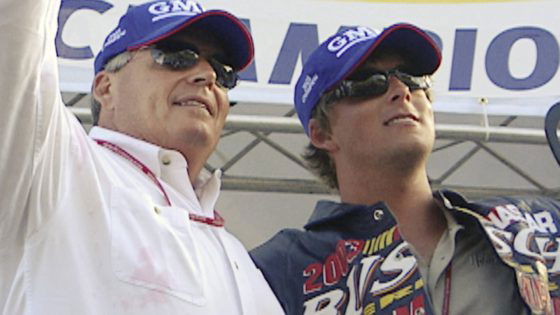
Imago
Hendrick Motorsports owner Rick Hendrick and son Ricky after the younger Hendrick’s Busch Series team won the 2023 championship, with Brian Vickers behind the wheel. Photo credit: Amazon Studios / Courtesy Everett Collection
And then there was Ricky’s ability to judge talent. Not only did he choose Vickers for his own team, Ricky, along with Jeff Gordon, convinced “Mr. H” to take a chance on a then relatively unknown young driver named Jimmie Johnson, who would go on to tie Richard Petty and Dale Earnhardt for most Cup championships (seven), as well as earn 83 Cup wins in his award-packed career.
ADVERTISEMENT
The Sunday morning flight, which was headed to Blue Ridge Regional Airport, just outside Martinsville, roughly 10 minutes west of the racetrack, was expected to take a little over an hour. The traveling party was supposed to land, hop in rented vehicles, and be at the track with plenty of time to spare before the green flag dropped. But fate had other plans.
Top Stories
NASCAR Champ’s Desperate Plea Got Rejected as Snowball Derby Official’s Bizarre Confession Sparks Outrage
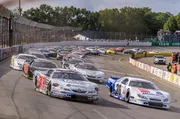
Carson Hocevar Shuts Down NASCAR Star’s Embarrassing Snowball Derby Tantrum in Blunt Social Media Takedown
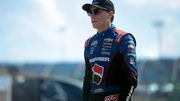
NASCAR Hits Back at Michael Jordan & Co.’s Key Witness After Shocking ‘Bankruptcy’ Claims
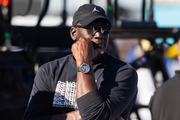
‘NASCAR on Sale’: Team Owners Interested to Buy Out France Family With $5B Price Tag

Federal Judge Puts NASCAR & Michael Jordan on Notice as Courtroom Frustration Mounts
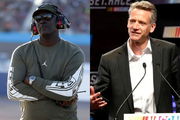
The tragedy came only a few years after Dale Earnhardt’s death
The heavy fog that blanketed southern Virginia that morning soon turned the day into one of unimaginable sorrow. Exactly, three years and eight months after NASCAR’s worst-ever tragedy – the death of seven-time Cup champ Dale Earnhardt in a final-lap crash in the 2001 Daytona 500 – those 10 passengers and pilots aboard the Hendrick plane never made it to Martinsville. All 10 were killed when the flight crashed into the upper terrain of 1,800-foot-high Bull Mountain.
ADVERTISEMENT
Because of the worsening weather conditions, the HMS plane was ordered by air traffic controllers to make another pass and attempt a landing again. Unfortunately, in just a few minutes, conditions became impossible.
According to the subsequent investigation by the National Transportation Safety Board and the Federal Aviation Administration, the crash resulted from a combination of pilot error and the near-zero visibility caused by the thick fog. The plane struck the mountainside, just 150 to 200 feet short of clearing its peak.
By the time the green flag dropped to begin the race at Martinsville, a massive search and rescue effort began, covering roughly 50 square miles. NASCAR officials kept their concern quiet, with only team, speedway, and Nextel officials being clued in. By around 4 p.m. ET, just before Jimmie Johnson would claim the victory, word had begun to filter out that the wreckage of the plane had been found on the side of Bull Mountain.
ADVERTISEMENT
And, sadly, there were no survivors.
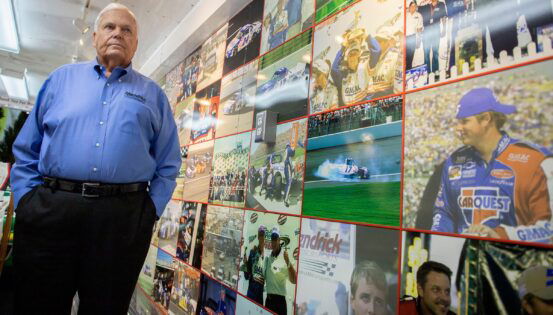
Imago
Rick Hendrick pauses to look at the wall of photos that line the trailer from his late son, Ricky Hendrick’s race team on display inside the 58,000-square foot Heritage Center in Concord, North Carolina on July 25, 2023. Rick Hendrick’s employees presented the trailer to him after the plane crash. It is filled with Ricky’s racing gear and other memorabilia. He points to RickyÕs radios, his small Go Kart sits on the floor, there are photos of Ricky at races and with his family hung throughout it.
ADVERTISEMENT
Chaos after the race
Once he crossed the finish line, Johnson was quickly hustled out of his race car on pit road and put in seclusion in an infield garage along with teammates Jeff Gordon, Terry Labonte, and Vickers, while all post-race celebration activities were promptly canceled, leaving the estimated 91,000 fans in the stands wondering what was happening.
It was around the same time that NASCAR officials began to notify all teams that there had been a catastrophic tragedy and that it had involved Team Hendrick. The information was shared in person, both on pit boxes and in team garages. Teams were ordered not to discuss the situation on their radios because so many fans in the stands listened to those frequencies.
Leading NASCAR Vice President of Corporate Communications Jim Hunter shared what he knew at the time to the national TV broadcast, and then shortly thereafter, revealed the horrible news on a live national radio broadcast that was also carried on the track’s public address system.
ADVERTISEMENT
The crash ultimately led pretty much every TV newscast in the country that evening and into the following day, as well as being front-page news on virtually every daily newspaper. And the Hendrick organization’s website crashed for nearly 12 hours due to overloaded use.
Why the race finish was minimized?
Seemingly lost in everything was that Johnson defeated Jaime McMurray, Ryan Newman, Sterling Marlin, and Kurt Busch, who four races later would claim the 2004 Nextel Cup championship.
ADVERTISEMENT
That day was unlike any I’ve ever experienced in my long career. I’ve probably covered well over 1,500 races in my time, primarily NASCAR, IndyCar, and NHRA, along with other series like Formula One and others.
Much like Earnhardt’s death, the Hendrick tragedy was an incident that cast a morose pall over the sport for weeks – if not months – to come. The 10 victims were memorialized six weeks later in the 2004 NASCAR Awards Banquet that December in New York City.
In search of where the tragedy occurred
One year later, on Monday, October 24, 2005, something pulled at my heart and sympathy strings. I know the damage and debris had long been cleaned up, but I wanted to see for myself where 10 innocent victims lost their lives. I had studied and read everything I could about the cause of the crash and the FAA’s report of what it believes happened.
No one was there to question the pilot’s judgment or error. I merely wanted to try and spiritually connect with the 10 souls who lost their lives on that fateful October day.
When I finally found Bull Mountain – and believe me, it was not the easiest place to locate – something happened that was one of the most eerie feelings I’ve ever experienced. Down a two-lane country road with a mountain on one side and farmland on the other, I pulled over onto a dirt road that led toward the mountain and exited my car.
With God as my witness, I still vividly recall that day just like I vividly recall the day of the actual incident. I got out of my rental car and walked maybe 100 feet toward the mountain. Darkness was beginning to close in, so I couldn’t see as clearly as I would have liked, but it was what I heard and felt – rather than what I saw – that ultimately shook me to my core.
The temperature unexpectedly dropped into the low 40s in what seemed like a matter of seconds, and the wind suddenly picked up to gusts of 25-plus mph, just like it did on that fateful day one year earlier. Clouds suddenly rolled in, as did fog. A light mist of rain began to fall as well. It was a typical, sharp autumnal early evening in the Martinsville area.
As I stood in silence, looking and listening, I suddenly heard a noise approaching from the west that continued to grow louder as each second passed. It honestly scared the bejesus out of me because I had to wonder if I was truly hearing what I thought I heard – an echo of the tragic plane – or was God and the atmosphere playing tricks on me.
Eventually, I could barely make out the taillight of a small plane – it appeared to be more of a two- or four-seater rather than the 12-seat capacity of the HMS Beechcraft 200 – and it flew by to the south side of Bull Mountain, inching closer to land at the airport that was supposed to also be Team Hendrick’s landing spot.
I stood in that area for a good 10 or 15 minutes, kind of afraid to move but also trying to help myself to understand somewhat of the same position that the 10 victims on the plane, totally unaware that their lives were about to end only seconds before the abrupt collision that sorrowfully ended their respective lives.
21 years later: Gone but never forgotten..
Sadly, this Friday marks the 21 anniversary of what is most commonly and simply known as “the Hendrick plane crash.”
Last year, Rick Hendrick and his wife Linda led a memorial marking 20 years since the terrible crash impacted so many families’ lives. The memorial was held in front of a ceremonial fountain that was erected shortly after the accident to remember the 10 victims.
“Never to be replaced and never to be forgotten but to always be loved and remembered,” Rick Hendrick said as part of his speech. He then somberly added, with a pain that still hurt deeply two decades later, “Never, ever forget these souls.”
ADVERTISEMENT
ADVERTISEMENT
ADVERTISEMENT

